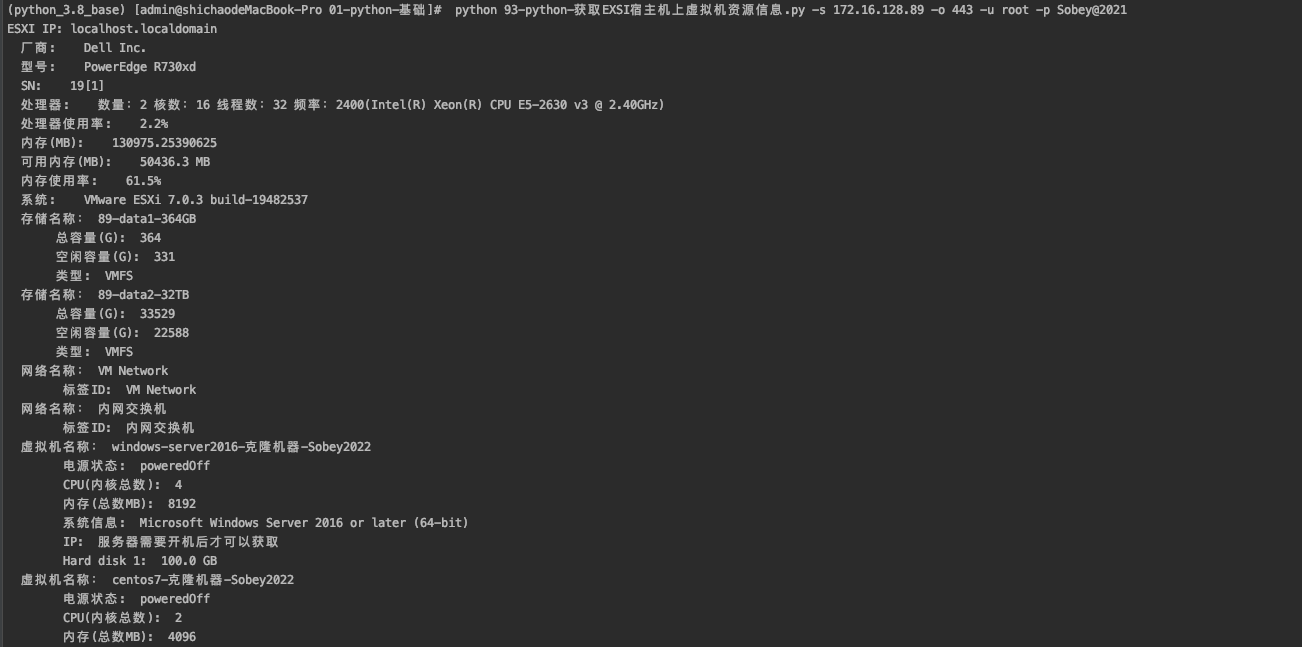python-获取EXSI宿主机上虚拟机资源信息
1. python-获取EXSI宿主机上虚拟机资源信息
-
安装包准备
# 所需安装包版本 python==3.8.4 pyVim==0.0.21 pyvmomi==6.7.1 # 安装命令: pip install pyVim==0.0.21 pyvmomi==6.7.1 -
编写获取
#!/usr/bin/python3 #coding:utf-8 """ 获取所有的vcenter相关信息 包括exsi的硬件资源信息和vmware客户端的硬件分配信息 """ from pyVmomi import vim from pyVim.connect import SmartConnect, Disconnect, SmartConnectNoSSL import atexit import argparse def get_args(): parser = argparse.ArgumentParser( description='Arguments for talking to vCenter') parser.add_argument('-s', '--host', required=True, action='store', help='vSpehre service to connect to') parser.add_argument('-o', '--port', type=int, default=443, action='store', help='Port to connect on') parser.add_argument('-u', '--user', required=True, action='store', help='User name to use') parser.add_argument('-p', '--password', required=True, action='store', help='Password to use') args = parser.parse_args() return args def get_obj(content, vimtype, name=None): ''' 列表返回,name 可以指定匹配的对象 ''' container = content.viewManager.CreateContainerView(content.rootFolder, vimtype, True) obj = [ view for view in container.view] return obj def main(): esxi_host = {} args = get_args() # connect this thing si = SmartConnectNoSSL( host=args.host, user=args.user, pwd=args.password, port=args.port) # disconnect this thing atexit.register(Disconnect, si) content = si.RetrieveContent() esxi_obj = get_obj(content, [vim.HostSystem]) for esxi in esxi_obj: esxi_host[esxi.name] = {'esxi_info':{},'datastore':{}, 'network': {}, 'vm': {}} esxi_host[esxi.name]['esxi_info']['厂商'] = esxi.summary.hardware.vendor esxi_host[esxi.name]['esxi_info']['型号'] = esxi.summary.hardware.model for i in esxi.summary.hardware.otherIdentifyingInfo: if isinstance(i, vim.host.SystemIdentificationInfo): esxi_host[esxi.name]['esxi_info']['SN'] = i.identifierValue esxi_host[esxi.name]['esxi_info']['处理器'] = '数量:%s 核数:%s 线程数:%s 频率:%s(%s) ' % (esxi.summary.hardware.numCpuPkgs, esxi.summary.hardware.numCpuCores, esxi.summary.hardware.numCpuThreads, esxi.summary.hardware.cpuMhz, esxi.summary.hardware.cpuModel) esxi_host[esxi.name]['esxi_info']['处理器使用率'] = '%.1f%%' % (esxi.summary.quickStats.overallCpuUsage / (esxi.summary.hardware.numCpuPkgs * esxi.summary.hardware.numCpuCores * esxi.summary.hardware.cpuMhz) * 100) esxi_host[esxi.name]['esxi_info']['内存(MB)'] = esxi.summary.hardware.memorySize/1024/1024 esxi_host[esxi.name]['esxi_info']['可用内存(MB)'] = '%.1f MB' % ((esxi.summary.hardware.memorySize/1024/1024) - esxi.summary.quickStats.overallMemoryUsage) esxi_host[esxi.name]['esxi_info']['内存使用率'] = '%.1f%%' % ((esxi.summary.quickStats.overallMemoryUsage / (esxi.summary.hardware.memorySize/1024/1024)) * 100) esxi_host[esxi.name]['esxi_info']['系统'] = esxi.summary.config.product.fullName for ds in esxi.datastore: esxi_host[esxi.name]['datastore'][ds.name] = {} esxi_host[esxi.name]['datastore'][ds.name]['总容量(G)'] = int((ds.summary.capacity)/1024/1024/1024) esxi_host[esxi.name]['datastore'][ds.name]['空闲容量(G)'] = int((ds.summary.freeSpace)/1024/1024/1024) esxi_host[esxi.name]['datastore'][ds.name]['类型'] = (ds.summary.type) for nt in esxi.network: esxi_host[esxi.name]['network'][nt.name] = {} esxi_host[esxi.name]['network'][nt.name]['标签ID'] = nt.name for vm in esxi.vm: esxi_host[esxi.name]['vm'][vm.name] = {} esxi_host[esxi.name]['vm'][vm.name]['电源状态'] = vm.runtime.powerState esxi_host[esxi.name]['vm'][vm.name]['CPU(内核总数)'] = vm.config.hardware.numCPU esxi_host[esxi.name]['vm'][vm.name]['内存(总数MB)'] = vm.config.hardware.memoryMB esxi_host[esxi.name]['vm'][vm.name]['系统信息'] = vm.config.guestFullName if vm.guest.ipAddress: esxi_host[esxi.name]['vm'][vm.name]['IP'] = vm.guest.ipAddress else: esxi_host[esxi.name]['vm'][vm.name]['IP'] = '服务器需要开机后才可以获取' for d in vm.config.hardware.device: if isinstance(d, vim.vm.device.VirtualDisk): esxi_host[esxi.name]['vm'][vm.name][d.deviceInfo.label] = str((d.capacityInKB)/1024/1024) + ' GB' f = open(args.host + '.txt', 'w') for host in esxi_host: print('ESXI IP:', host) f.write('ESXI IP: %s \n' % host) for hd in esxi_host[host]['esxi_info']: print(' %s: %s' % (hd, esxi_host[host]['esxi_info'][hd])) f.write(' %s: %s' % (hd, esxi_host[host]['esxi_info'][hd])) for ds in esxi_host[host]['datastore']: print(' 存储名称:', ds) f.write(' 存储名称: %s \n' % ds) for k in esxi_host[host]['datastore'][ds]: print(' %s: %s' % (k, esxi_host[host]['datastore'][ds][k])) f.write(' %s: %s \n' % (k, esxi_host[host]['datastore'][ds][k])) for nt in esxi_host[host]['network']: print(' 网络名称:', nt) f.write(' 网络名称:%s \n' % nt) for k in esxi_host[host]['network'][nt]: print(' %s: %s' % (k, esxi_host[host]['network'][nt][k])) f.write(' %s: %s \n' % (k, esxi_host[host]['network'][nt][k])) for vmachine in esxi_host[host]['vm']: print(' 虚拟机名称:', vmachine) f.write(' 虚拟机名称:%s \n' % vmachine) for k in esxi_host[host]['vm'][vmachine]: print(' %s: %s' % (k, esxi_host[host]['vm'][vmachine][k])) f.write(' %s: %s \n' % (k, esxi_host[host]['vm'][vmachine][k])) f.close() if __name__ == '__main__': main() -
获取结果查看

标注是
-s IP地址
-o 指定是http还是https协议
-u 指定是访问用户名
-p 指定密码
2. 改造原有脚本式,通过传参控制封装
-
编写脚本
#!/usr/bin/python3 # coding:utf-8 """ 获取所有的vcenter相关信息 包括exsi的硬件资源信息和vmware客户端的硬件分配信息 """ from pyVmomi import vim from pyVim.connect import SmartConnect, Disconnect, SmartConnectNoSSL import atexit import argparse # 面向对象操作 class EsxiTest(): def __init__(self, ip, port, username, password): self.ip = ip self.port = port self.username = username self.password = password def Esxi_command(self): esxi_host = {} # 连接esxi Esxi_Connect = SmartConnectNoSSL(host=self.ip, port=self.port, user=self.username, pwd=self.password) atexit.register(Disconnect, Esxi_Connect) content = Esxi_Connect.RetrieveContent() esxi_content = content.viewManager.CreateContainerView(content.rootFolder, [vim.HostSystem], True) esxi_obj = [ view for view in esxi_content.view ] for esxi in esxi_obj: esxi_host[esxi.name] = {'esxi_info': {}, 'datastore': {}, 'network': {}, 'vm': {}} esxi_host[esxi.name]['esxi_info']['厂商'] = esxi.summary.hardware.vendor esxi_host[esxi.name]['esxi_info']['型号'] = esxi.summary.hardware.model for i in esxi.summary.hardware.otherIdentifyingInfo: if isinstance(i, vim.host.SystemIdentificationInfo): esxi_host[esxi.name]['esxi_info']['SN'] = i.identifierValue esxi_host[esxi.name]['esxi_info']['处理器'] = '数量:%s 核数:%s 线程数:%s 频率:%s(%s) ' % ( esxi.summary.hardware.numCpuPkgs, esxi.summary.hardware.numCpuCores, esxi.summary.hardware.numCpuThreads, esxi.summary.hardware.cpuMhz, esxi.summary.hardware.cpuModel) esxi_host[esxi.name]['esxi_info']['处理器使用率'] = '%.1f%%' % (esxi.summary.quickStats.overallCpuUsage / ( esxi.summary.hardware.numCpuPkgs * esxi.summary.hardware.numCpuCores * esxi.summary.hardware.cpuMhz) * 100) esxi_host[esxi.name]['esxi_info']['内存(MB)'] = esxi.summary.hardware.memorySize / 1024 / 1024 esxi_host[esxi.name]['esxi_info']['可用内存(MB)'] = '%.1f MB' % ( (esxi.summary.hardware.memorySize / 1024 / 1024) - esxi.summary.quickStats.overallMemoryUsage) esxi_host[esxi.name]['esxi_info']['内存使用率'] = '%.1f%%' % ((esxi.summary.quickStats.overallMemoryUsage / ( esxi.summary.hardware.memorySize / 1024 / 1024)) * 100) esxi_host[esxi.name]['esxi_info']['系统'] = esxi.summary.config.product.fullName for ds in esxi.datastore: esxi_host[esxi.name]['datastore'][ds.name] = {} esxi_host[esxi.name]['datastore'][ds.name]['总容量(G)'] = int((ds.summary.capacity) / 1024 / 1024 / 1024) esxi_host[esxi.name]['datastore'][ds.name]['空闲容量(G)'] = int((ds.summary.freeSpace) / 1024 / 1024 / 1024) esxi_host[esxi.name]['datastore'][ds.name]['类型'] = (ds.summary.type) for nt in esxi.network: esxi_host[esxi.name]['network'][nt.name] = {} esxi_host[esxi.name]['network'][nt.name]['标签ID'] = nt.name for vm in esxi.vm: esxi_host[esxi.name]['vm'][vm.name] = {} esxi_host[esxi.name]['vm'][vm.name]['电源状态'] = vm.runtime.powerState esxi_host[esxi.name]['vm'][vm.name]['CPU(内核总数)'] = vm.config.hardware.numCPU esxi_host[esxi.name]['vm'][vm.name]['内存(总数MB)'] = vm.config.hardware.memoryMB esxi_host[esxi.name]['vm'][vm.name]['系统信息'] = vm.config.guestFullName if vm.guest.ipAddress: esxi_host[esxi.name]['vm'][vm.name]['IP'] = vm.guest.ipAddress else: esxi_host[esxi.name]['vm'][vm.name]['IP'] = '服务器需要开机后才可以获取' for d in vm.config.hardware.device: if isinstance(d, vim.vm.device.VirtualDisk): esxi_host[esxi.name]['vm'][vm.name][d.deviceInfo.label] = str( (d.capacityInKB) / 1024 / 1024) + ' GB' for host in esxi_host: print('ESXI IP:', host) for hd in esxi_host[host]['esxi_info']: print(' %s: %s' % (hd, esxi_host[host]['esxi_info'][hd])) for ds in esxi_host[host]['datastore']: print(' 存储名称:', ds) for k in esxi_host[host]['datastore'][ds]: print(' %s: %s' % (k, esxi_host[host]['datastore'][ds][k])) for nt in esxi_host[host]['network']: print(' 网络名称:', nt) for k in esxi_host[host]['network'][nt]: print(' %s: %s' % (k, esxi_host[host]['network'][nt][k])) for vmachine in esxi_host[host]['vm']: print(' 虚拟机名称:', vmachine) for k in esxi_host[host]['vm'][vmachine]: print(' %s: %s' % (k, esxi_host[host]['vm'][vmachine][k])) if __name__ == '__main__': ssh = EsxiTest("172.16.128.89", "443", "root", "123456") result = ssh.Esxi_command() print(result)
























